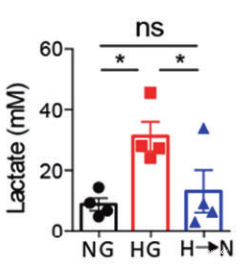L-Lactic Acid (LA) Colorimetric Assay Kit
SKU: E-BC-K044-M-500
L-Lactic Acid (LA) Colorimetric Assay Kit
| SKU # | E-BC-K044-M |
| Detection Instrument | Microplate reader(520-540 nm, optimum wavelength: 530 nm) |
| Detection Method | Colorimetric method |
Product Details
Properties
| Sample Type | Serum, plasma, cell culture supernatant, tissue, cells |
| Sensitivity | 0.10 mmol/L |
| Detection Range | 0.12-7.0 mmol/L |
| Detection Method | Colorimetric method |
| Assay type | Quantitative |
| Assay time | 30 min |
| Precision | Average inter-assay CV: 3.500% | Average intra-assay CV: 1.400% |
| Other instruments required | Micropipettor, Centrifuge, Incubator, Vortex mixer |
| Other reagents required | Normal saline (0.9% NaCl), PBS (0.01 M, pH 7.4) |
| Storage | 2-8℃ |
| Valid period | 12 months |
Images
H Mu at al investigate the glucose metabolism that controlled human tumor immunosurveillance in diabetes. L-Lactate (L-LA) of cell supernatant was determined using L-lactate colorimetric assay kit (E-BC-K044-M).

Lactate secretion was significantly increased in HG group. (*P<0.05)
Dilution of Sample
It is recommended to take 2~3 samples with expected large difference to do pre-experiment before formal experiment and dilute the sample according to the result of the pre-experiment and the detection range (0.12-7.0 mmol/L).
The recommended dilution factor for different samples is as follows (for reference only):
| Sample type | Dilution factor |
| Human serum | 2-5 |
| 10% Rat kidney tissue homogenate | 1-3 |
| 10% Rat brain tissue homogenate | 1 |
| HepG2 cell culture supernatant | 1 |
| HepG2 cells | 1 |
Note: The diluent is normal saline (0.9% NaCl), PBS (0.01 M, pH 7.4).
Detection Principle
Using NAD+ as H+ receptor, LDH catalyzes the reaction of lactic acid and NAD+ to generate pyruvic acid and NADH respectively. NBT is reduced to a kind of purple compound during the reaction. Measure the OD value at 530 nm, and the concentration of lactic acid can be calculated.
Kit Components & Storage
| Item | Component | Size 1(48 T) | Size 2(96 T) | Storage |
| Reagent 1 | Buffer Solution | 6 mL × 1 vial | 6 mL × 2 vials | 2-8℃, 12 months |
| Reagent 2 | Enzyme Stock Solution | 0.06 mL × 1 vial | 0.06 mL × 2 vials | 2-8℃, 12 months |
| Reagent 3 | Chromogenic Agent |
1.2 mL × 1 vial | 1.2 mL × 2 vials | 2-8℃, 12 months shading light |
| Reagent 4 | Stop Solution | 12 mL × 1 vial | 12 mL × 2 vials | 2-8℃, 12 months |
| Reagent 5 | 10 mmol/L Lactic Acid Standard |
1 mL × 1 vial | 1 mL × 2 vials | 2-8℃, 12 months |
| Microplate | 96 wells | No requirement | ||
| Plate Sealer | 2 pieces | |||
Note: The reagents must be stored strictly according to the preservation conditions in the above table. The reagents in different kits cannot be mixed with each other. For a small volume of reagents, please centrifuge before use, so as not to obtain sufficient amount of reagents.
Technical Data:
Parameter:
Intra-assay Precision
Three human serum samples were assayed in replicates of 20 to determine precision within an assay (CV = Coefficient of Variation).
| Parameters | Sample 1 | Sample 2 | Sample 3 |
| Mean (mmol/L) | 0.50 | 2.10 | 4.60 |
| %CV | 1.8 | 1.2 | 1.2 |
Inter-assay Precision
Three human serum samples were assayed 20 times in duplicate by three operators to determine precision between assays
| Parameters | Sample 1 | Sample 2 | Sample 3 |
| Mean (mmol/L) | 0.50 | 2.10 | 4.60 |
| %CV | 3.1 | 3.4 | 4.0 |
Recovery
Take three samples of high concentration, middle concentration and low concentration to test the samples of each concentration for 6 times parallelly to get the average recovery rate of 105%.
| Standard 1 | Standard 2 | Standard 3 | |
| Expected Conc. (mmol/L) | 1.5 | 3.6 | 5.4 |
| Observed Conc. (mmol/L) | 1.6 | 3.7 | 5.7 |
| Recovery rate (%) | 106 | 103 | 106 |
Sensitivity
The analytical sensitivity of the assay is 0.10 mmol/L. This was determined by adding two standard deviations to the mean O.D. obtained when the zero standard was assayed 20 times, and calculating the corresponding concentration.
Standard Curve:
As the OD value of the standard curve may vary according to the conditions of the actual assay performance (e.g. operator, pipetting technique or temperature effects), so the standard curve and data are provided as below for reference only:
| Concentration (μmol/L) | 0 | 1 | 2 | 3 | 4 | 5 | 6 | 7 |
| Average OD | 0.160 | 0.466 | 0.805 | 1.082 | 1.327 | 1.601 | 1.784 | 2.042 |
| Absoluted OD | 0.000 | 0.307 | 0.646 | 0.923 | 1.167 | 1.442 | 1.624 | 1.882 |



